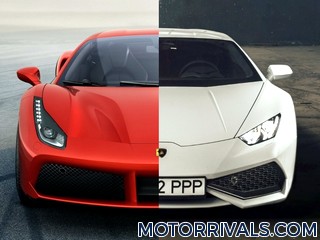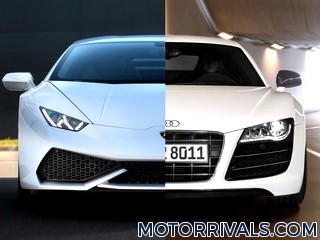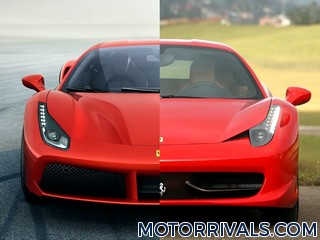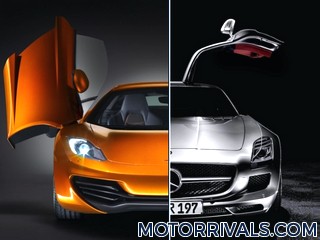2016 Audi R8 V10 vs 2016 Lamborghini Huracan LP 610-4
Audi R8 V10 Press Release Highlights
No model with the four rings is closer to motorsport, none is more
striking and more dynamic: at the 2015 Geneva Motor Show, Audi is
presenting the second generation of its high-performance R8 sports car.
The V10 mid-engine and a newly developed quattro drive ensure
breathtaking driving performance, especially in the top-of-the-range
version with 449 kW (610 hp): achieving 0 to 100 km/h (62.1 mph) in just
3.2 seconds, its top speed is 330 km/h (205.1 mph).
A high-revving mid-engine with superior performance, a consistently lightweight construction concept and an extremely dynamic chassis with quattro drive system and fully variable torque control - this is what makes the R8 the sporty spearhead of Audi. The high-performance sports car has been newly developed from the ground up - it is more taut, more striking and more fascinating both on the race track and on the road.
The engines: 10 cylinders in two versions
The 5.2 FSI is available in two versions: one with 397 kW (540 hp) and another sporting 449 kW (610 hp). The range-topping model accelerates in a mere 3.2 seconds from 0 to 100 km/h (62.1 mph) and keeps going to its maximum speed of 330 km/h (205.1 mph). The sound of the freely aspirated V10 engine, whose maximum torque is available at 6,500 rpm, has become even fuller and sharper. A 7-speed S tronic transmission and a newly developed quattro drive system transmit the power to the road. The distribution of the drive torque adapts to the respective driving conditions - in extreme cases, 100 percent of the torque can be transmitted to the front or rear axle. The new performance mode in the Audi drive select dynamic handling system enables adaptation of the most important ride dynamics parameters to the friction coefficient of the road.
Lightweight construction: only 1,454 kg (3,205.5 lb) dry weight
The top model R8 V10 plus has a dry weight of 1,454 kilograms (3,205.5 lb). Despite a lot of extra equipment and greater rigidity, the new Audi R8 weighs up to 50 kilograms (110.2 lb) less than its predecessor. The multimaterial Audi Space Frame (ASF) ensures low weight and optimum axle load distribution. The combination of aluminum and carbon fiber reinforced plastics (CFRP) in the Audi Space Frame opens up new dimensions with regard to weight, rigidity and crash behavior. The aerodynamic underbody which integrates a long diffuser boosts downforce. The chassis, too, with its double wishbone suspension demonstrates how close the new Audi R8 is to motorsport.
Sales of the new Audi R8 start in summer 2015. Prices are 165,000 euros for the R8 V10 and 187,400 euros for the top-of-the-range version R8 V10 plus.
Specialists: the Audi R8 e-tron and Audi R8 LMS
The second generation of the Audi R8 forms the basis for more models. The latest evolutionary version of the electrically-powered high-performance R8 e-tron sports car achieves a performance figure of 340 kW and a torque of 920 Nm (678.6 lb-ft). It sprints from a standstill to 100 km/h (62.1 mph) in 3.9 seconds. Thanks to new battery cells, the range could be more than doubled compared to the first version of this technological wonder - it is now more than 450 kilometers (279.6 mi).
The new Audi R8 LMS race car was developed based on the new GT3 regulations due to come into effect worldwide from 2016. This year it will already be put through its paces at the factory. Despite massive performance increases, around 50 percent of its components are the same as the series-production car.
A high-revving mid-engine with superior performance, a consistently lightweight construction concept and an extremely dynamic chassis with quattro drive system and fully variable torque control - this is what makes the R8 the sporty spearhead of Audi. The high-performance sports car has been newly developed from the ground up - it is more taut, more striking and more fascinating both on the race track and on the road.
The engines: 10 cylinders in two versions
The 5.2 FSI is available in two versions: one with 397 kW (540 hp) and another sporting 449 kW (610 hp). The range-topping model accelerates in a mere 3.2 seconds from 0 to 100 km/h (62.1 mph) and keeps going to its maximum speed of 330 km/h (205.1 mph). The sound of the freely aspirated V10 engine, whose maximum torque is available at 6,500 rpm, has become even fuller and sharper. A 7-speed S tronic transmission and a newly developed quattro drive system transmit the power to the road. The distribution of the drive torque adapts to the respective driving conditions - in extreme cases, 100 percent of the torque can be transmitted to the front or rear axle. The new performance mode in the Audi drive select dynamic handling system enables adaptation of the most important ride dynamics parameters to the friction coefficient of the road.
Lightweight construction: only 1,454 kg (3,205.5 lb) dry weight
The top model R8 V10 plus has a dry weight of 1,454 kilograms (3,205.5 lb). Despite a lot of extra equipment and greater rigidity, the new Audi R8 weighs up to 50 kilograms (110.2 lb) less than its predecessor. The multimaterial Audi Space Frame (ASF) ensures low weight and optimum axle load distribution. The combination of aluminum and carbon fiber reinforced plastics (CFRP) in the Audi Space Frame opens up new dimensions with regard to weight, rigidity and crash behavior. The aerodynamic underbody which integrates a long diffuser boosts downforce. The chassis, too, with its double wishbone suspension demonstrates how close the new Audi R8 is to motorsport.
Sales of the new Audi R8 start in summer 2015. Prices are 165,000 euros for the R8 V10 and 187,400 euros for the top-of-the-range version R8 V10 plus.
Specialists: the Audi R8 e-tron and Audi R8 LMS
The second generation of the Audi R8 forms the basis for more models. The latest evolutionary version of the electrically-powered high-performance R8 e-tron sports car achieves a performance figure of 340 kW and a torque of 920 Nm (678.6 lb-ft). It sprints from a standstill to 100 km/h (62.1 mph) in 3.9 seconds. Thanks to new battery cells, the range could be more than doubled compared to the first version of this technological wonder - it is now more than 450 kilometers (279.6 mi).
The new Audi R8 LMS race car was developed based on the new GT3 regulations due to come into effect worldwide from 2016. This year it will already be put through its paces at the factory. Despite massive performance increases, around 50 percent of its components are the same as the series-production car.
Lamborghini Press Release Highlights
Automobili Lamborghini is taking a major step into the future: with the
newly developed Huracán LP 610-4, the successor to the highly successful
Gallardo, the Italian super sports car manufacturer is redefining the
benchmark in the segment. With its pure and absolute design,
breathtaking dynamics and excellent quality, the Huracán delivers an
unparalleled sports car experience. It unites mighty performance with a
character perfectly suited to everyday use; its wide-ranging new
technologies work together in a fully integrated fashion. Stephan
Winkelmann, President and CEO of Automobili Lamborghini said: "With the
Huracán, Lamborghini is writing the next chapter in its great history."
With the Huracán LP 610-4, Lamborghini is taking its purist, unmistakable design language to a whole new evolutionary level. The design is bold and edgy, with beautifully sculptural forms. The starting point of the design process was the Huracán's silhouette. The objective was to define the car with a single line stretching from the front end over the passenger cell to the rear. The side windows take on a hexagonal form that looks like a gem set into the profile of the Huracán. At night, too, it is utterly unmistakable: All lights, including the main headlamps, beam in LED technology - an absolute first in the super sports car segment.
An innovative cockpit dominates the interior. The 12.3-inch TFT display can be configured in a number of different modes and provides the driver with all key information in a virtual format. The slender lines of the instrument mounts and the center tunnel are indicative of the lightness of the interior design. Fine materials distinguish the interior, which can be extensively individualized, while the extremely detailed craftsmanship delivers a highly refined sense of quality.
The newly conceived hybrid chassis of the Huracán LP 610-4 is a technical work of art that unites carbon-fiber and aluminum components. The ultralight chassis forms the basis for the vehicle’s low dry weight of 1,422 kilograms; with its excellent stiffness, it guarantees the handling precision of a racing car.
The new V10 engine in the Huracán generates its phenomenal propulsion from a displacement of 5.2 liters. It produces a power output of 448 kW / 610 hp at 8,250 rpm and a maximum torque of 560 Nm at 6,500 rpm. The new "Iniezione Diretta Stratificata" combines direct and indirect injection - achieving an increase in power and torque compared with the Gallardo and a decrease in fuel consumption and emissions.
With its power-to-weight ratio of just 2.33 kilograms per hp, the Lamborghini Huracán achieves absolutely breathtaking performance. The top speed of more than 325 km/h and the acceleration figures - zero to 100 km/h in 3.2 seconds, zero to 200 km/h in 9.9 seconds – offer an indication of its dynamics. Thanks in part to the Stop & Start technology, ECE average fuel consumption has dropped to 12.5 liters per 100 km (290 g CO2 per km).
The power generated by the ten-cylinder is delivered to the road via the new 7-speed dual-clutch transmission "Lamborghini Doppia Frizione" (LDF) and an all-wheel drive that also features a new hydraulic multi-plate clutch. Three different driving modes, spanning from road to race track, can be selected using a drive select switch in the steering wheel. The system is called ANIMA (Italian for Soul) - "Adaptive Network Intelligent Management", and impacts the engine, the transmission, the all-wheel drive and the ESC handling system as well as other dynamic systems.
With the Huracán LP 610-4, Lamborghini is taking its purist, unmistakable design language to a whole new evolutionary level. The design is bold and edgy, with beautifully sculptural forms. The starting point of the design process was the Huracán's silhouette. The objective was to define the car with a single line stretching from the front end over the passenger cell to the rear. The side windows take on a hexagonal form that looks like a gem set into the profile of the Huracán. At night, too, it is utterly unmistakable: All lights, including the main headlamps, beam in LED technology - an absolute first in the super sports car segment.
An innovative cockpit dominates the interior. The 12.3-inch TFT display can be configured in a number of different modes and provides the driver with all key information in a virtual format. The slender lines of the instrument mounts and the center tunnel are indicative of the lightness of the interior design. Fine materials distinguish the interior, which can be extensively individualized, while the extremely detailed craftsmanship delivers a highly refined sense of quality.
The newly conceived hybrid chassis of the Huracán LP 610-4 is a technical work of art that unites carbon-fiber and aluminum components. The ultralight chassis forms the basis for the vehicle’s low dry weight of 1,422 kilograms; with its excellent stiffness, it guarantees the handling precision of a racing car.
The new V10 engine in the Huracán generates its phenomenal propulsion from a displacement of 5.2 liters. It produces a power output of 448 kW / 610 hp at 8,250 rpm and a maximum torque of 560 Nm at 6,500 rpm. The new "Iniezione Diretta Stratificata" combines direct and indirect injection - achieving an increase in power and torque compared with the Gallardo and a decrease in fuel consumption and emissions.
With its power-to-weight ratio of just 2.33 kilograms per hp, the Lamborghini Huracán achieves absolutely breathtaking performance. The top speed of more than 325 km/h and the acceleration figures - zero to 100 km/h in 3.2 seconds, zero to 200 km/h in 9.9 seconds – offer an indication of its dynamics. Thanks in part to the Stop & Start technology, ECE average fuel consumption has dropped to 12.5 liters per 100 km (290 g CO2 per km).
The power generated by the ten-cylinder is delivered to the road via the new 7-speed dual-clutch transmission "Lamborghini Doppia Frizione" (LDF) and an all-wheel drive that also features a new hydraulic multi-plate clutch. Three different driving modes, spanning from road to race track, can be selected using a drive select switch in the steering wheel. The system is called ANIMA (Italian for Soul) - "Adaptive Network Intelligent Management", and impacts the engine, the transmission, the all-wheel drive and the ESC handling system as well as other dynamic systems.






















